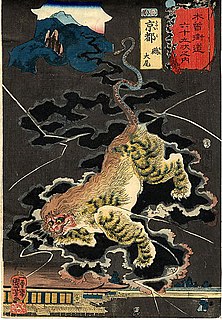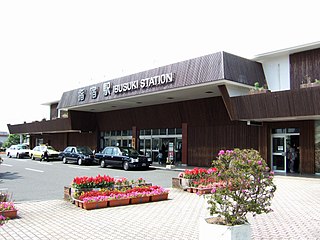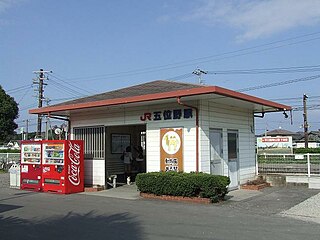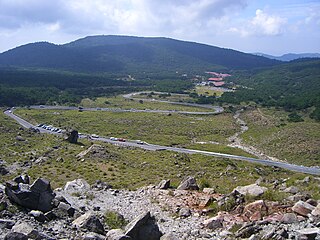
Kagoshima Prefecture is a prefecture of Japan located on the island of Kyushu. The capital is the city of Kagoshima.

The Nue is a legendary Japanese yōkai or mononoke.

China is a town located on Okinoerabujima, in Ōshima District, Kagoshima Prefecture, Japan.
Kyōiku kanji, also known as Gakunenbetsu kanji haitōhyō is a list of 1,006 kanji and associated readings developed and maintained by the Japanese Ministry of Education that prescribes which kanji, and which readings of kanji, Japanese schoolchildren should learn for each year of primary school. Although the list is designed for Japanese children, it can also be used as a sequence of learning characters by non-native speakers as a means of focusing on the most commonly used kanji. (ja:学年別漢字配当表)
Shinigami are gods or supernatural spirits that invite humans toward death, and can be seen to be present or interpreted to be present in certain aspects of Japanese religion and culture. Shinigami have been described as monsters and helpers, creatures of darkness, and fallen angels. Many cultures describe Shinigami as Death themselves.
Japanese place names include names for geographic features, present and former administrative divisions, transportation facilities such as railroad stations, and historic sites in Japan. The article Japanese addressing system contains related information on postal addresses.

Ibusuki Station is a railway station on the Ibusuki Makurazaki Line in Ibusuki, Kagoshima, Japan, operated by Kyushu Railway Company. The station opened in 1934.
Groups of Traditional Buildings is a Japanese category of historic preservation introduced by a 1975 amendment of the law which mandates the protection of groups of traditional buildings which, together with their environment, form a beautiful scene. They can be post towns, castle towns, mining towns, merchant quarters, ports, farming or fishing villages, etc. The Japanese government's Agency for Cultural Affairs recognizes and protects the country's cultural properties under the Law for the Protection of Cultural Properties.

Kobayashi Station is a train station in Kobayashi, Miyazaki Prefecture, Japan. It is operated by JR Kyushu and is on the Kitto Line.

Kiire Station is a railway station located in Kagoshima, Kagoshima, Japan. The station opened in 1934.

Goino Station is a railway station located in Kagoshima, Kagoshima, Japan. The station opened in 1930.

Ōsumi-Ōkawara Station is a railway station in Soo, Kagoshima, Japan. It is operated by of JR Kyushu and is on the Nippō Main Line.

Kurama-dera (鞍馬寺) is a temple in the far north of Kyoto, Japan which houses some National Treasures of Japan. It was a member of the Tendai sect and subordinate to Shōren-in from the 12th century until 1949 when it founded its own religious body. The object of worship is esoteric and unique to the temple. It is said to have been founded by a disciple of Jianzhen.

Kitsunebi (狐火) is an atmospheric ghost light told about in legends all across Japan outside Okinawa Prefecture. They are also called "hitobosu", "hitomoshi" (火点し), and "rinka" (燐火).

Ebino Plateau is a basin within the Mount Kirishima mountain ranges, situated in southern Kyushu, Japan. It is surrounded by the Mount Shiratori, Mount Karakuni, Mount Ebino and Mount Koshiki mountain peaks.
Mononoke (物の怪) are vengeful spirits (onryō), dead spirits (shiryō), live spirits (ikiryō), or spirits in Japanese classical literature and folk religion that were said to do things like possess individuals and make them suffer, cause disease, or even cause death. It is also a word sometimes used to refer to yōkai or henge.
Maruoka Kanji was Governor of Okinawa Prefecture (1888–1892) and governor of Kōchi Prefecture (1892).
The Kanto Three Great Acalas (関東三大不動) is a collective term, recorded in the Japanese history, for the three temples that are dedicated to the Acala in Kantō region governed by shōgun.

















